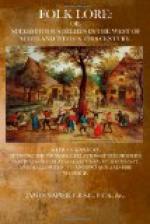In Britain sun-worship appears to have been purer in prehistoric than it afterwards was in historic times, purer also than the sun-cult of historic Egypt, Greece, or Rome; that is, there appears to have been in British sun-worship less of polytheism than prevailed in Egypt, Greece, or Rome. But during the historic period, the numerous invasions and the colonizations of different portions of this country by the Romans and other nations, who brought with them their special religious beliefs and formulae of worship, caused the increase of polytheism by the commingling of the foreign and native elements of belief, and later on, these were mixed with Christianity, and in these mixings all the elements became modified, so that now it is very difficult to separate with certainty the aboriginal, invasional, and Christian elements.
From many indications it seems more than probable that the sun-cult in prehistoric Britain was very similar, even in many minor points, to the solar worship of the ancient Peruvians. At the same time, there is not the slightest probability that these two widely separated sun-cults ever had a common point of historical connection, nor, in order to explain their similarities, is such an historical explanation necessary. Quite sufficient is the explanation that both possessed in common a human nature, emotional and intellectual, moving on the same plane of childlike intelligence, and that both from this common standpoint had regard to the same striking and regularly recurring scenes of natural phenomena. Prescott thus describes the worship of these ancient Peruvians:—“The Sun was their primary God; to it was built a vast temple in the capital, more radiant with gold than that of Solomon’s; and every city had a temple dedicated to the sun, and blasphemy against the sun was punished with death. The principal festivals of the year were at the equinoxes and solstices. That at midsummer was the grandest. It was preceded by a three days’ fast; then every one who had time and money visited the city. Great fires were kindled from the sun’s rays or by friction, from which sacred fires people kindled their hearth;” all household fires having previously been extinguished. Poor countries and districts, where the arts were in a backward condition, instead of having temples like the Peruvians, dedicated mountains and stone circles to the great luminary. It is the all but universal opinion that in this country, centuries before the Christian era, the religion of the people was Druidism; but this is merely the name of a system, and is equivalent to our saying that the present religion of our country is Presbyterianism, a statement which conveys no idea of the nature of our religious worship. The Druids were a priestly order who governed the country, and directed the worship of the people, the principal objects of worship being, as we have already said, the sun and fire. “The Druids,” says the late Rev. James Rust, “formed an ecclesiastico-political




